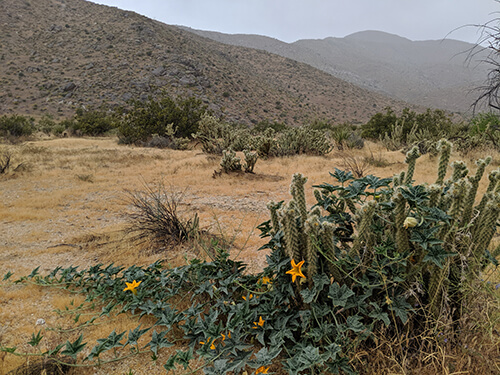Wild plants face viral surprise
Article Highlights
- Viruses from agriculture are infecting wild, native plants in neighboring habitats, according to new research from Michigan State University and the University of California, Riverside.
- This discovery, published in Phytobiomes Journal, holds significant implications for conservation efforts, the researchers said.
- “These wild plants are crucial components of desert ecosystems, providing food and habitat for other species. Their decline from crop virus infections could have cascading effects on entire ecological communities,” said Carolyn Malmstrom, one of the study’s leaders.
Just as many people battle seasonal colds and flu, native plants face their own viral threats. People have long known that plants can succumb to viruses just like humans. Now, a new study led by Michigan State University and the University of California, Riverside reveals a previously unknown threat: non-native crop viruses are infecting and jeopardizing the health of wild desert plants.
“For years, the ecological field assumed wild plants were immune to invasive viruses that damage crops,” said Carolyn Malmstrom, a professor in the Department of Plant Biology and a co-leader of the study. Kerry Mauck, an associate professor and Alfred M. Boyce Endowed Chair in Entomology, was the team leader at UC Riverside and adviser for the lead author Tessa Shates, who was a graduate student in the Mauck Lab.

By analyzing native plants, such as this wild squash, in the Californian desert, a team of researchers from Michigan State University and the University of California, Riverside revealed that non-native viruses from agriculture are invading these habitats. Credit: Tessa Shates
“But we’ve found that we need to be just as concerned about protecting indigenous plants as we are agricultural ones,” said Malmstrom, who is also a faculty member with the Ecology, Evolution and Behavior program, or EEB, at MSU.
Published March 26 in the Phytobiomes Journal, this discovery holds significant implications for conservation efforts. The research utilizes advanced genetic sequencing and field experiments to demonstrate how insects, acting as unwitting infectors, ferry harmful pathogens from cultivated fields to native ecosystems.
The study focused on desert regions of Southern California, where the Cucurbita species of wild squash thrived alongside irrigated agriculture. The team meticulously identified, marked and collected samples from the wild plants.
Then, analyzing the genetic makeup of viruses within these wild plants, the researchers discovered a surprising presence of crop pathogens like cucurbit yellow stunting disorder virus and cucurbit aphid-borne yellows virus, or CABYV.
In fact, they found that infection rates with CABYV — a non-native pathogen — could reach as high as 88% in some wild Cucurbita populations, with visible impacts on plant growth and root health, both vital for the plants’ survival in the harsh desert environment.

“These wild plants are crucial components of desert ecosystems, providing food and habitat for other species,” Malmstrom said. “Their decline from crop virus infections could have cascading effects on entire ecological communities.”
“Our findings should help the greater community recognize that our impact on the landscapes around us are not always obvious or clear to see,” Shates said. “It’s easy to see the landscape changes of a clear-cut forest, but it is harder to recognize how hitchhiking microbes might change plant community structure over time.”
Plant virology and research at MSU
Collaboration across the country and fields of research was an important facilitator of this research. Having leading experts in plant biology and entomology contributed to the scientific success of the project, as well as the growth of its early-career researchers.
“In addition to her own contributions, Dr. Malmstrom has been a great mentor throughout this study,” said Shates, who is now an infectious disease scientist with the research company Quest Diagnostics.
“Doing this research, especially during the pandemic, required learning new skills and expanding my research toolkit,” Shates said. “Dr. Malmstrom was a great resource for recommending technical methods to try for data analysis and generating ‘genomes’ for the viruses in our samples.”
As an AgBioResearch scientist, Malmstrom was also able to tap into both agricultural and natural systems expertise at MSU.
“This project bridges the gap between agriculture and natural systems, reminding us that nature and agriculture are intricately linked,” said Malmstrom. “It also underscores the need for a more holistic approach to managing plant health and shows that understanding the complex dynamics of viruses in natural systems is essential for developing sustainable solutions that benefit both agriculture and biodiversity.”
To learn more about plant virology research at MSU, visit the Malmstrom lab.